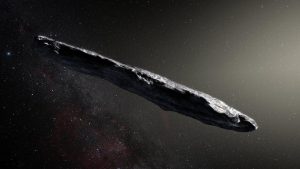In October, astronomers at the University of Hawaiʻi at Mānoa Institute for Astronomy (IfA) made a stunning discovery with the Pan-STARRS1 telescope—the first interstellar object seen passing through our Solar System. Now, an international team lead by IfA Astronomer Karen Meech has made detailed measurements of the visitor’s properties. “This thing is very strange,” said Meech.
Originally denoted A/2017 U1 (with the A for “asteroid”), the body is now the first to receive an “I” (for interstellar) designation from the International Astronomical Union, which created the new category after the discovery.

In addition, it has been officially given the name ʻOumuamua. The name, which was chosen in consultation with UH Hilo Hawaiian language experts Kaʻiu Kimura and Larry Kimura, reflects the way this object is like a scout or messenger sent from the distant past to reach out to us (ʻou means “reach out for” and mua, with the second mua placing emphasis, means “first, in advance of”). The object’s full official name is 1I/2017 U1 (ʻOumuamua), and can also be correctly referred to as 1I, 1I/2017 U1, and 1I/ʻOumuamua.
ʻOumuamua is rapidly fading as it heads out of the Solar System and recedes from both the Sun and the Earth, so getting new observations as fast as possible was crucial. The IfA team—including those who discovered 1I—was already prepared to rapidly follow up solar system discoveries from Pan-STARRS, which is operated by IfA and funded by NASA.
“We were able to rapidly develop a follow-up strategy on a very short timescale. It is exciting to think that the brief visit by ʻOumuamua gave us the opportunity to do the first characterization of a sample from another solar system,” says Meech. As a result, they are the first to publish their results—“A brief visit from a red and extremely elongated interstellar asteroid”—appearing in the online issue of the journal Nature on November 20.
For more on the discovery and images, read IfA’s news release.
—By Roy Gal

